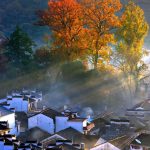When autumn drapes its golden veil over Jiangxi Province, Wuyuan becomes one of the most poetic places in all of China. Known as “the most beautiful village in China,” Wuyuan turns into a gentle dreamscape in fall — where white-walled houses peek through misty valleys, red leaves shimmer on the hills, and baskets of harvest goods glow like brushstrokes of color on a living canvas.

Visiting Wuyuan in autumn is like stepping inside a traditional Hui-style ink painting — except here, the soft black ink lines are alive, dancing with hues of gold, orange, and red. It’s both a painter’s paradise and a traveler’s cozy escape.
The Warm Colors of an Ink Painting
The charm of autumn in Wuyuan lies in its perfect blend of nature and culture. As the season deepens, fields of rice turn golden, persimmons ripen on trees, and old stone houses glimmer under slanting sunlight. Every ancient village—be it Likeng, Jiangling, or Huangling—feels like a quiet poem written by time itself. The Hui-style architecture, with its black tiles and white walls, makes the colors of autumn even more vivid, creating the signature “living ink painting” view that defines Wuyuan’s beauty.
The “Shai Qiu” Tradition: Autumn on the Rooftops
One of the most beloved scenes in Wuyuan during autumn is the ancient folk custom called “Shai Qiu,” or the Sun-Drying Festival. In villages like Huangling, rooftops transform into brilliant palettes, covered with round bamboo trays filled with red chili peppers, golden corn, and orange persimmons. Locals dry their harvest under the sun while chatting across the rooftops, creating a heartwarming scene of daily life that doubles as living art.
From above, the colorful grains and produce look like a giant oil painting, and photographers from around the world gather to capture it. This ritual not only celebrates abundance but also connects people with the rhythm of nature — a perfect example of Wuyuan’s blend of folk culture and aesthetic beauty.
Maple Leaf Secrets: A Fiery Fairytale in the Mountains
Autumn in Wuyuan wouldn’t be complete without its maple leaf wonderlands. The best-known spot is Wuyuan’s Hongcun, where ancient maple trees—some over 800 years old—ignite in crimson and amber every late October. When morning mist floats over the red forests and stone bridges, the whole valley feels like an impressionist painting come alive.

For travelers who love hiking and photography, the maple-lined paths of Caihong Valley or Jiangwan Village offer some of the most breathtaking views in all of Jiangxi Province. Each turn of the road reveals new textures of red, orange, and gold, and every breeze carries the scent of harvest and nostalgia.
Ancient Villages: Where Time Walks Slowly
Wuyuan’s beauty is more than its scenery — it’s also in its ancient villages. With more than 50 preserved settlements, Wuyuan is a living museum of Hui culture. Walking through Likeng Village, you can see elegant stone bridges, mossy lanes, and delicate carvings on old wooden doors. Sixiyan Village and Wangkou Village showcase the architectural charm of the Ming and Qing dynasties, where symmetry, elegance, and nature blend seamlessly.

In autumn, smoke curls from chimneys, elders dry herbs in courtyards, and children play along the streams. Every corner carries the warmth of everyday life — gentle, slow, and filled with quiet poetry.
Cultural Heritage: The Heartbeat of Hui Civilization
Wuyuan was once the hometown of Hui merchants, whose trade and scholarship shaped the region’s identity. Their motto — “to farm and study for the family” — lives on in the traditions of literacy, craftsmanship, and harmony with nature. Festivals like the Anhui Opera performances, ancestor worship ceremonies, and autumn harvest fairs add a cultural rhythm to the scenic tranquility.
Wuyuan’s intangible cultural heritage also includes wood carving, tea-making, and ink-stick craftsmanship, all of which tell stories of patience and artistry. Autumn, with its slower pace and mild weather, is the perfect season to experience these local crafts and connect with the soul of old Hui culture.
Travel Guide: Everything You Need to Know
Transportation:
Wuyuan is accessible by high-speed train from Hangzhou, Nanchang, or Huangshan. The Wuyuan Railway Station connects easily to local buses and taxis bound for the scenic villages.
Accommodation:
Traditional guesthouses (minsu) in the old villages offer cozy stays with wooden interiors, mountain views, and home-cooked meals. For more comfort, boutique lodges near Huangling or Jiangling provide stunning views right from your window.
Clothing:
Autumn temperatures range from 10–20°C. Bring a light jacket, comfortable walking shoes, and layers for cool mornings and evenings.
Tickets:
Wuyuan has multiple scenic areas, each requiring an entry ticket. A combined ticket is available and recommended for multi-day visits.
Etiquette:
Respect local traditions, especially in villages where residents still live. Avoid stepping on drying produce during the “Shai Qiu” season, and always greet locals with a friendly smile.
Why Jiangxi Wuyuan Is the Perfect Autumn Getaway
Wuyuan in autumn is not just a place — it’s a feeling. A harmony of nature, culture, and human warmth, where rooftops bloom with color and mountains whisper with ancient stories. From fiery maple forests to the fragrance of sun-dried harvests, every corner glows with quiet happiness.

It’s a journey into Hui culture, a walk through China’s most beautiful villages, and a gentle reminder that art and life are often one and the same.
Contact us today to craft your dream China adventure!

